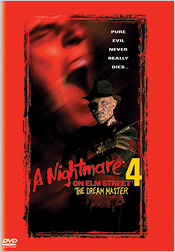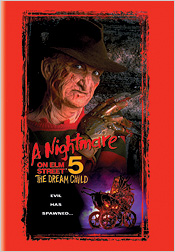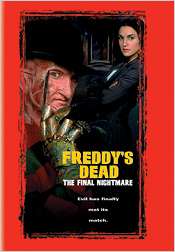 |
-Established 1997-

page added: 11/3/11
A Nightmare on Elm Street: The Franchise
An appreciation and reviews by Tim Salmons of The Digital Bits
back to Page One
|
The story also further developed the idea of Freddy needing the souls of his victims in order to thrive, except in this instance, the 'powers' of his victims were taken in by shy and uninteresting Alice (played wonderfully by Lisa Wilcox). By the end of the film, Alice becomes a courageous and strong young woman, giving her character a real arc (a story device that hadn't been used in the series up to this point). There were also some very bizarre ideas utilized for the film, including the resurrection of Freddy by way of a dog pissing fire onto his resting place.
The film also combined the talents of many of the best special make-up and technical effects wizards including Jim Doyle, John Carl Buechler, Screaming Mad George, Howard Berger and Kevin Yagher, many of whom had worked on the previous films. Old school mechanical and special effects were in their prime, and whether they were being done in-camera or optically, they worked fantastically on audiences. The only problem during the shoot was Robert Shaye's reservations about Renny Harlin. By this point, New Line was beginning to get very protective of their biggest money maker and weren't easily swayed when it came to new approaches and fresh ideas. Renny Harlin has stated in interviews that he was sure that he would have been fired from the project at any time because he didn't feel that Robert Shaye had the utmost confidence in him to deliver a quality film that the company could sell. It didn't really matter all that much because Freddy's popularity was bigger than ever and even a bad film in the series would have made its money back no matter what. Thankfully, Harlin wasn't relying on that and attempted to make something the Nightmare fans would embrace. Given a summer release on August 19, 1988, The Dream Master was an enormous success. Not only that, but it was the biggest money maker of the series and validated Renny Harlin as a talented and valuable young director to many, including Shaye. Fans came out in droves to see Freddy's latest and were cheering him on at every turn. Upon release, Freddy became so mainstream that it was impossible to take him seriously anymore as a dark character, something that would hurt the franchise in future entries. The Dream Master was also the first of the series to be released during New Line Cinema's heyday as a major independent studio before becoming a major Hollywood force. Complete with their new (and now famous) logo, it was more than clear that the studio was here to stay. The success gave Renny Harlin a chance to go on and make a string of financially successful action and suspense films while giving the studio an opportunity to seek out new franchises, but the success would prove to be bittersweet for the Nightmare series. |
|
Alice, Alice's father and Dan from The Dream Master returned to reprise their roles, making Alice the only female character to survive more than one film (obviously discounting Nancy/Heather in New Nightmare, which was more of a hybrid character). Working hard to deliver a visually interesting film (perhaps the most interesting of the series), Stephen Hopkins' background as an art director gave him more of an artistic visual edge than previous directors. Unfortunately, the story itself was sacrificed and rushed just to get another film into theatres.
Once again the writers delved into Freddy's backstory by bringing his mother into the forefront of the story and resurrecting Freddy through her. The convoluted story involved Freddy using Alice's unborn child to continue invading teenager's dreams, something which Alice put a stop to in the previous film. It was a more mature approach that dealt with issues of child abandonment, rape and abortion, which hadn't been dealt with in the series before. In retrospect, it tends to stick out as one of the most socially-conscious entries in the franchise, but it seemed more like a David Lynch nightmare than your usual run-of-the-mill Nightmare film. However, the studio was willing to go with a fresh approach in fear of the series becoming stale. Like the last film, The Dream Child also brought a lot of talented special effects wizards in to work on it. Freddy's literal rebirth in the film gave the make-up artists a chance to redesign his make-up. Unfortunately, it's the weakest and least-effective make-up job in the series, but thankfully the effects that make up the rest of the film are superior and highly-imaginative. Everything from rear screen projection, stop-motion animation to faux black and white photography was used to great effect. Though visually interesting, the physical effects tended to stray more into gory territory, even more so than previous entries. This caused the MPAA to come down hard on the original cut of the movie, which became truncated in the final version. It didn't help the film in the long run and left some audience members scratching their heads as to what exactly was going on during some of the dream sequences. Released on August 11, 1989, The Dream Child saw a disappointing decline at the box office upon its release. It was technically a financial success, but it was nowhere near the hit that The Dream Master had been and wasn‘t an enormous profit for the studio. It saw the poorest performance of any of the films in the series at the time and was a let-down for many of its followers. Fortunately, its aftermarket life proved to be more lucrative. When originally released on home video, the unrated version of The Dream Child was included which featured all of the graphic footage that the MPAA had made the filmmakers cut out to get an R rating reinstated. Meanwhile, New Line Cinema was busy pursuing different avenues to find worthy new film properties, including chasing the rights to the Friday the 13th series from Paramount. Between the studio's involvement with other promising directions and The Dream Child's lackluster box office performance, it was decided to end the series with one final entry. |
|
Twin Peaks had the heaviest influence on the film, as did the work of John Waters. Featuring cameos from the likes of Roseanne, Tom Arnold and Alice Cooper, it was a chance to have some fun with the story. Hoping to hook audiences with a gimmick after the disappointing box office figures from The Dream Child, it was decided that the final portion of the film would be shot in 3D. Although it worked for the most part, story and effects elements were downplayed in order to achieve it, which is a mistake Rachel has often commented on.
The Final Nightmare was also the least direct sequel of the franchise. Taking place sometime in the future when Springwood has been wiped clean of anyone under 20, it featured absolutely none of the characters from the previous films, except for Freddy himself. In the final installment, Freddy has run out of teenagers in Springwood and is looking to jump ship. The only way he can do that is through his daughter. He sends the character of John, the last remaining teenager from Springwood with a bad case of amnesia, out into the world to find her. Unfortunately, Rachel's quirky style displeased a lot of the fan base while Freddy's demise seemed to walk down familiar territory, making it more of a joke than enthralling to most fans. The Final Nightmare also featured a lot of new young talent like Breckin Meyer and Ricky Dean Logan, the latter of whom went on to be a successful character actor. There was also a bit of gravitas given to the film in the lead roles with Lisa Zane and veteran Yaphet Kotto. The film was one of the few sequels that had the most additional footage hit the cutting room floor. Bootlegs of this footage have been floating around for years but none of it has yet made any official releases. With a wealth of great talent both behind and in front of the camera, it was one of the easiest and most trouble-free shoots of the series. The biggest headaches stemmed from the team trying to get the 3D to work properly, but they would soon find out if that would pay off. Released on September 13, 1991, The Final Nightmare was released to slightly more enthusiastic response than its predecessor. Fans happily turned up for Freddy's supposed final bow, but it wasn't without its drawbacks. Still lacking the kind of box office draw that New Line was hoping for, the series truly died with this film. It was very much a 'Twin Peaks meets Looney Tunes' sort of horror film and fans were generally displeased with the results - citing it as one of, if not, the worst of the series. To add insult to injury, when it was originally released on home video, the 3D portion was removed due to the limitations of the format. What was leftover were actors sticking objects awkwardly at the camera lens trying to make the 3D work. The original version of the film wasn't seen until almost 8 years later when it was released on DVD in New Line's Nightmare series boxed set - with 3D glasses thrown in for good measure. It's almost sad to think that the series really ended the way it did, without its creator coming back for one last stab (pun intended) at bringing Freddy Krueger back to his roots. It might have been a lost cause due to the character's popularity and how overexposed he had become, but unfortunately (or fortunately, depending on how you look at it), the original storyline would never see another entry... but it wasn't the last time that we would be seeing Freddy. |
 |
| Site
designed for 1024 x 768 resolution, using 16M colors and .gif 89a
animation. © 1997-2015 The Digital Bits, Inc., All Rights Reserved. billhunt@thedigitalbits.com |


